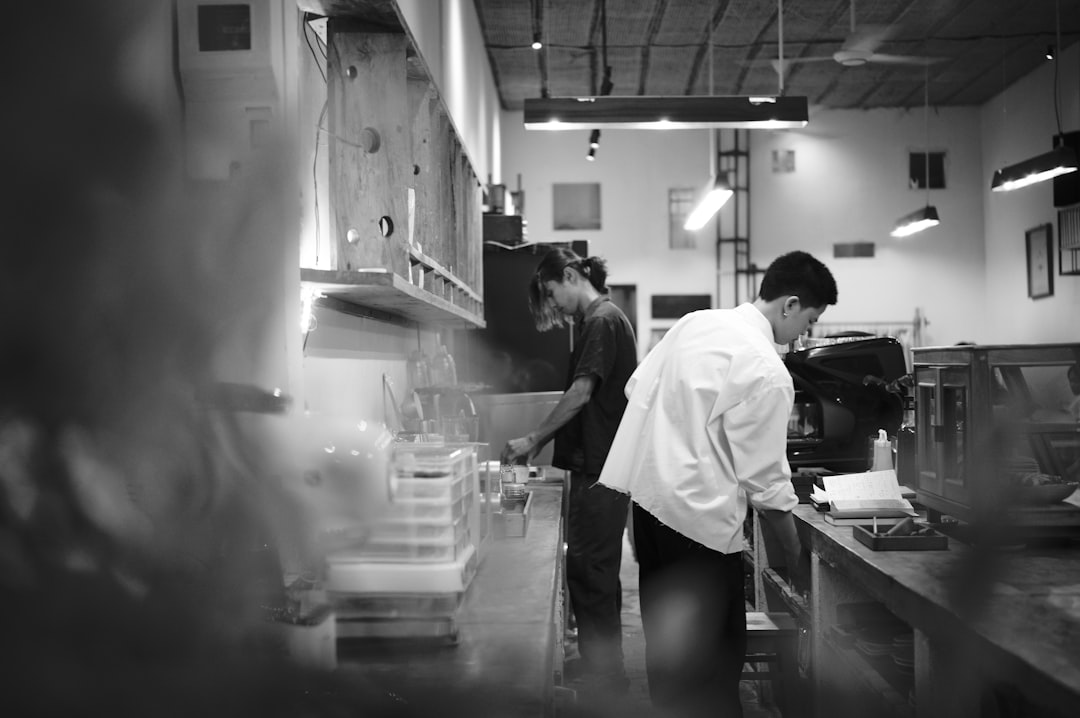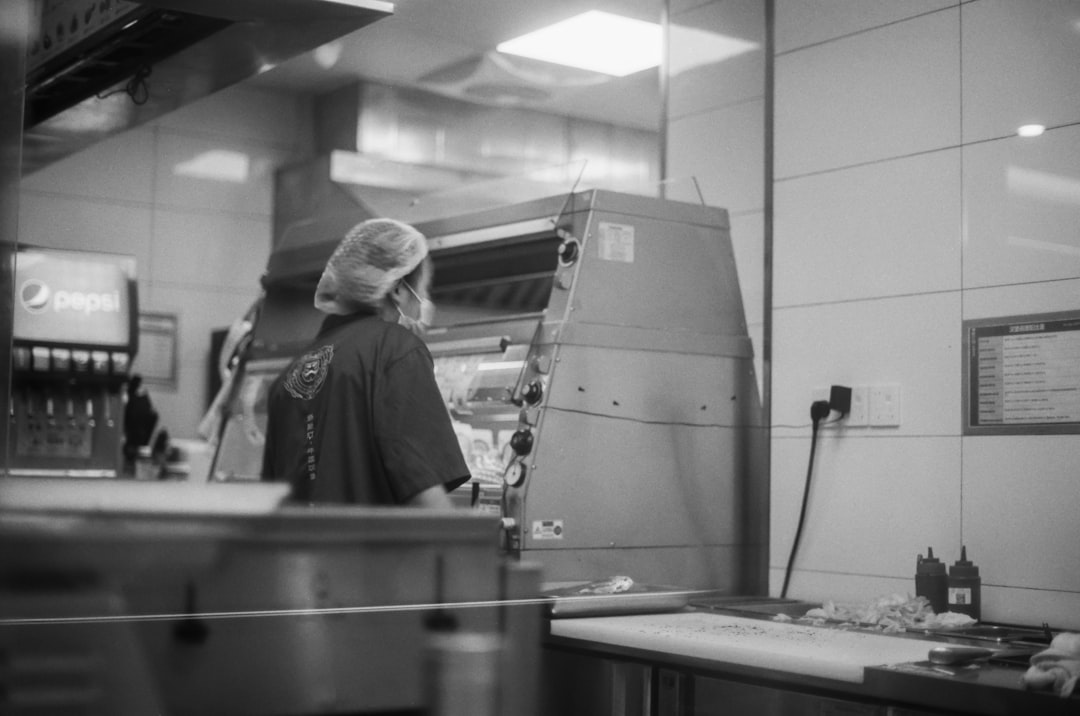

Engage prospects with a scan and streamline customer engagement with FREE QR code marketing tools by Sona – no strings attached!
Create a Free QR CodeFree consultation

No commitment

Engage prospects with a scan and streamline customer engagement with FREE QR code marketing tools by Sona – no strings attached!
Create a Free QR CodeFree consultation

No commitment
Restaurant equipment repair services face immense pressure to reduce downtime, control costs, and maintain food safety standards. These challenges directly impact operational efficiency and revenue, yet many teams still struggle with disjointed information flows and outdated tracking methods that cause lost opportunities and longer downtimes. When time-sensitive issues are logged on paper or routed through a busy phone line, the delay compounds both service costs and operational risk.
When service requests or part orders are not immediately digitized, critical issues often slip through the cracks. Frustration mounts when high-value prospects, such as chain restaurant managers needing urgent repairs, are not tracked in the CRM. This leads to missed revenue and dissatisfied clients, while restaurant staff delay reporting issues until they escalate, consuming extra resources and compounding costs. Every hour a walk-in cooler or combi oven remains down, kitchens lose productivity and customer satisfaction declines.
As technology transforms the industry, QR codes in marketing have emerged as a practical way to close the gap between physical restaurant operations and digital service management. By affixing smart codes to kitchen equipment, businesses gain immediate access to maintenance schedules, emergency repair requests, or inventory reordering: reducing paperwork, cutting lost opportunities, and creating better data for long-term decision-making. QR codes convert every physical touchpoint into a digital signal that can be tracked, prioritized, and acted upon with speed. See creative QR ideas for inspiration.

Legacy approaches in restaurant equipment repair often result in missed or delayed orders, especially when requests are lost in phone queues or handwritten logs. Teams frequently encounter incomplete order histories and lack real-time tracking, causing frustrated staff and increased equipment downtime. Converting these analog workflows to QR-enabled digital pathways accelerates ordering, improves accuracy, and strengthens accountability across locations.
To move from slow, error-prone processes to streamlined ordering, start by aligning QR deployment with clear business goals and frontline behaviors. Replace clipboards and manual intake with scan-and-submit forms that capture context instantly, such as equipment type, asset ID, error codes, and urgency. Integrate the resulting data to your CRM and service platform so technicians can schedule, stage parts, and notify managers without delay. This combination shortens cycle times and ensures every request is visible from intake to resolution.
Modern solutions allow repair teams to move workflows from analog to automated, transforming every scan into a prioritized signal that is never lost. Some providers can even automate the capture and syncing of service requests, reducing manual intervention and ensuring consistent customer experiences across multiple locations. With a platform like Sona QR product overview, operators can create dynamic codes, route scans to the right destination, and measure downstream outcomes such as completed work orders or part sales.

Restaurant equipment repair companies contend with the risks of unknown or anonymous requests. Often, high-value prospects browse service offerings or encounter problems but never reach out via traditional channels. Without digital capture at the point of need, these potential leads remain invisible and unpursued, resulting in missed revenue for both emergency and recurring repairs. QR codes address this by putting a scannable entry point exactly where issues occur: on the equipment itself, on invoices, and in kitchen common areas.
Speed and simplicity are essential in a high-pressure kitchen. No one wants to create a login or search for a phone number during a rush. A QR code can preload a repair form with an asset ID, snap a photo of the issue, and submit to dispatch in seconds. For managers and technicians, dynamic QR codes make it easy to update destinations as equipment changes, manuals are revised, or workflows evolve, without reprinting thousands of labels. For practical restaurant applications, explore restaurant QR examples.
Technology has made it possible to connect every frontline interaction to actionable insight, giving repair companies a way to capture and cultivate opportunities that previously went unnoticed. The result is a measurable lift in speed to service, fewer missed calls, and a more complete picture of performance at the asset and account level. For sector-specific ideas, explore restaurants.

In day-to-day operations, missed or misrouted requests often trace back to generic QR deployments or static links that do not adjust as services, parts, or client needs change. Repair teams that adopt flexible, dynamic QR approaches see fewer lost opportunities and can adjust quickly to market or operational shifts. The key is to match the QR format to the intended action and the environment where it will be scanned.
For restaurant equipment repair, a mix of web links, pre-filled forms, and SMS triggers handles most workflows, while vCards and Wi-Fi credentials support communication and connectivity on site. Dynamic QR codes are especially valuable since they allow you to swap destinations or update content without relabeling assets. This is critical when SOPs or documentation must change across multiple franchise locations.
Integrated dashboards enable easy management of all QR assets, minimizing confusion and ensuring each code delivers the right outcome for staff, technicians, and customers. With Sona QR, you can generate any of these formats, manage them centrally, and keep everything aligned with evolving workflows.

Many repair services underutilize their physical and digital assets, failing to identify where customer demand or repetitive issues actually occur. Incomplete or outdated account data leads to missed segmentation and poorly targeted outreach. QR codes provide direct insight into who is engaging and why, making it easier to spot trends and allocate resources effectively.
By placing unique, trackable QR codes wherever staff interact with equipment or paperwork, operators build a living map of service demand and satisfaction using stickers and labels. These signals reveal which kitchens need more proactive maintenance, where parts inventory should be staged, and which accounts are primed for advanced service agreements or extended warranties.
These targeted placements enable repair operators to build a more accurate, granular understanding of customer needs and proactively adjust staffing, inventory, and outreach accordingly. Over time, aggregated scan data can highlight which brands of equipment drive the most service calls, which shifts report issues fastest, and which facility types benefit most from PM programs.

QR codes shine when they trigger actions that shorten the path from problem to solution. In a busy kitchen environment, this means immediate access to service requests, instant part reordering, and up-to-date maintenance history without hunting through binders or chasing emails. By standardizing these workflows, operators reduce lost work orders and create a consistent, trackable process across all locations.
Well-designed QR programs often generate measurable improvements, such as a 15 to 35 percent reduction in order cycle time and a 20 to 40 percent increase in on-time preventive maintenance completion. Results vary by fleet size and training, yet the direction is clear: fewer missed calls, clearer accountability, and faster fixes.
Smart QR implementations help surface previously hidden signals, such as repeated scans on particular assets or frequent access to a specific troubleshooting page. These patterns can trigger targeted outreach, part recommendations, or contract expansion discussions at exactly the right time.
Each QR code scan is a signal that captures intent, context, and behavior. By deploying multiple QR codes across equipment, paperwork, and signage, you can segment your audience automatically and use that data to fuel precise retargeting and follow-up campaigns. The goal is to meet each stakeholder where they are in the journey: from first-time incident reporters to multi-location operations leaders seeking fleet-level SLAs. See intent-driven retargeting for tactics.
Think about audience distinctions that matter in restaurant operations. Kitchen leads need quick fixes and clear status updates, general managers care about uptime and labor balance, and franchise operators value chain-wide analytics and predictable cost structures. Tagging scans by role, location type, and urgency makes it easy to personalize communication without extra manual effort.
With a platform like Sona QR, each code becomes a smart entry point into your funnel, capturing data that helps you retarget based on real behavior. For restaurant equipment repair, useful segments include single-location independents versus multi-unit groups, high-urgency responders versus proactive PM users, and specific equipment owners such as bakeries with deck ovens or QSRs with high-capacity fryers.
Disconnected or inconsistent messaging across channels often leaves prospects disengaged or confused, and can result in wasted marketing and service spend. QR codes unify communications by connecting each offline touchpoint to the right digital action. Every scan can carry context about where it occurred and what the user likely needs, which allows you to tune content and follow-up accordingly.
Restaurant equipment repair services rely on a mix of print, field service, and digital channels. QR codes make these assets measurable and interactive. Whether a scan comes from an installation manual, a magnet on the service panel, or a trade show booth, you can route the user to the best next step and capture useful data about demand.
When managed from a central platform, this unified approach ensures every scan is trackable and every outreach is tuned to where the customer is in their decision process. With Sona QR, repair services can monitor performance in real time and sync data to CRM and ad platforms for coordinated follow-up.
Launching a QR program should follow a structured plan that aligns with business objectives and frontline realities. This checklist guides you through choosing the right use case, building and testing codes, deploying across the right assets, and closing the loop with analytics. Adding a training component ensures that cooks, managers, and technicians all understand why scanning matters and what happens next.
Before you start, audit your current intake and ordering workflows. Identify bottlenecks such as phone queues, unread inboxes, or manual data entry. Define desired outcomes, such as reducing urgent repair response time by 25 percent or doubling preventative maintenance enrollments. Then use the steps below to roll out QR codes with confidence and clarity.
Start creating QR codes for free.
In the restaurant equipment repair industry, simply tracking scan counts does not reveal the full value of QR code deployments. Many companies still lack visibility into which engagements turn into actual orders, which makes it difficult to justify spend or optimize campaigns. See single vs multi-touch attribution models for frameworks.
Robust analytics connect physical touchpoints to operational outcomes. Tag each code to the specific asset and location, then push scan and completion data into your CRM or service platform. This creates a single source of truth that shows how QR initiatives contribute to faster time to dispatch, higher PM compliance, and lower repeat visit rates. For measuring offline touchpoints, see Sona’s offline attribution guide.
With Sona QR and Sona, teams can track every scan, measure engagement by channel and context, respond in real time, and sync results to core systems. Sona QR captures time, device, location, and campaign source. Sona.com enriches leads, resolves identities across touchpoints, and attributes revenue to QR-influenced journeys. This unified view helps operators understand how QR engagement contributes to pipeline, closed revenue, and customer lifetime value.
QR programs thrive when they are simple to use, easy to find, and clearly tied to meaningful outcomes. To scale success, refine your code inventory, optimize design and messaging, and automate follow-up so no signal is wasted. Training is just as important as technology. Staff should know what happens after a scan and how to explain benefits to colleagues.
Choose a few high-impact tactics to start, then iterate based on data. If scan volume is strong but completion is weak, improve the form. If scans are low, adjust placement, size, or CTA. If certain assets create outsized demand, stage parts and prioritize triage accordingly. Over time, expect to see lower downtime, faster ordering, and stronger customer satisfaction.
QR codes have shifted from simple convenience tools to essential catalysts in the evolution of restaurant equipment repair services. By linking physical operations with comprehensive digital workflows, teams gain the transparency and precision needed to reduce downtime, capture every qualified lead, and prevent both missed revenue and customer frustration. As solutions advance, companies that integrate granular scan data, automate follow-up, and map every engagement back to operational and financial outcomes will build resilience and unlock new growth in a demanding industry.
QR codes have revolutionized the restaurant equipment repair services industry by streamlining the ordering process and enhancing operational efficiency. By enabling quick access to repair requests, parts catalogs, and service scheduling, QR codes reduce downtime and accelerate repair turnaround times—delivering faster, more reliable service to your clients. Imagine instantly identifying which equipment needs urgent attention and seamlessly managing orders without the usual delays.
With Sona QR, you can create dynamic, trackable QR codes that update in real time, giving you full control over your repair workflows and customer interactions. No need for reprinting—simply modify your campaigns on the fly and connect every scan directly to actionable data that improves service delivery and drives client satisfaction. Start for free with Sona QR today and transform how you manage restaurant equipment repairs—turning every scan into a faster fix and a stronger customer relationship.
Look for repair services that use digital tools like QR codes to enable quick, trackable service requests and integrate with CRM systems to ensure fast response and accountability.
Common restaurant equipment requiring maintenance includes ovens, walk-in coolers, combi ovens, dish machines, refrigerators, and other high-use kitchen machinery.
Repair costs vary, but delays and repeated visits increase expenses; using QR-enabled digital workflows can reduce downtime and control repair costs by improving efficiency.
Signs include equipment downtime, declining kitchen productivity, recurring issues detected through maintenance logs, and staff reporting problems via QR code scans or other channels.
Prevent breakdowns by using QR codes to maintain up-to-date maintenance schedules, enabling instant service requests, accessing troubleshooting guides, and tracking preventive maintenance compliance.
QR codes enable fast, frictionless service requests, real-time tracking, automated routing, updated digital manuals, actionable data on equipment issues, and improved customer engagement.
They replace manual logs with scan-and-submit forms capturing asset details instantly, integrate requests with CRM systems, shorten order cycle times, and provide end-to-end visibility.
Common types include dynamic web links, pre-filled forms, SMS triggers, vCards for contacts, Wi-Fi access codes, and static codes for fixed resources like manuals.
By placing unique QR codes on equipment, contracts, invoices, and signage, services capture scan data that reveals demand patterns, enabling targeted maintenance, inventory staging, and upsell campaigns.
Use cases include equipment-linked service requests, instant parts reorder, digital maintenance logs, self-service troubleshooting, and post-service feedback and warranty registration.
They segment scans by user role, location, and urgency, tag codes by use case and stage, and sync data with CRM and ad platforms for personalized retargeting and follow-up.
QR codes unify print, digital, and field channels by linking offline assets like brochures, signage, mailers, and events to tailored online actions and measurable engagement.
Define clear goals and audience, choose dynamic QR types, design and test codes for scannability, deploy on priority assets, and track and optimize performance continuously.
Integrating scan data with CRM systems enables detailed attribution of service requests and orders, improving operational visibility, reducing missed calls, and linking campaigns to revenue.
Use unique codes per asset and location, apply UTM tagging, automate follow-ups, train all staff on QR benefits, and deploy creative, targeted QR applications to capture valuable insights.
Use Sona QR's trackable codes to improve customer acquisition and engagement today.
Create Your FREE Trackable QR Code in SecondsJoin results-focused teams combining Sona Platform automation with advanced Google Ads strategies to scale lead generation

Connect your existing CRM

Free Account Enrichment

No setup fees
No commitment required

Free consultation

Get a custom Google Ads roadmap for your business






Launch campaigns that generate qualified leads in 30 days or less.
